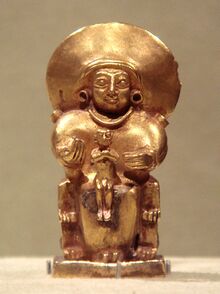حناحنا
حنـّاحنـّا ( Ḫannaḫanna من الكلمة الحيثية حنـّا ḫanna- "جدة"[1])، هي إلهة أم حيثية.[2] وهي تناظر الإلهة الأم دينگيرماح في الديانات الرافدية.
. . . . . . . . . . . . . . . . . . . . . . . . . . . . . . . . . . . . . . . . . . . . . . . . . . . . . . . . . . . . . . . . . . . . . . . . . . . . . . . . . . . . . . . . . . . . . . . . . . . . . . . . . . . . . . . . . . . . . . . . . . . . . . . . . . . . . . . . . . . . . . . . . . . . . . . . . . . . . . . . . . . . . . . .
الأساطير
تظهر حنـّاحنـّا في عدد من الأساطير الحيثية، حيث تميل إلى المساعدة في حل المشاكل التي يواجهها الآلهة الآخرون.[3] معظمها أساطير تتناول اختفاء الآلهة، وهو موضوع مشترك في الأساطير الحيثية.
أساطير تلپينو
بعد اختفاء تلپينو، اشتكى والده، إله العواصف ترحونا، إلى حنـّاحنـّا. ومن ثم أرسلها للبحث عن ابنه، وعندما استسلمت، أرسلت نحلة، وأمرتها بالبحث عن تلپينو. فعلت النحلة ذلك، ثم طهرته وقوته بلسع يديه وقدميه ومسح عينيه وقدميه بالشمع.[4][5]
في أسطورة أخرى عن اختفاء تلپينو، أوصت حنـّاحنـّا بأن يدفع لأرونا مهر العروس لابنة إله البحر، حتى تتمكن من الزواج من تلپينو.[6]
أسطورة اختفاء إينارا
في أسطورة أخرى اختفت إينارا وعندما أُبلغت حنـّاحنـّا بهذا الأمر من خلال نحلة إله العواصف، بدأت على ما يبدو في البحث عن إينارا بمساعدة خادمتها.[7]
أسطورة اختفاء حنـّاحنـّا
في أسطورة غير مجتزأة، أخفت حنـّاحنـّا نفسها لفترة من الوقت في نوبة غضب. أثناء غيابها، اختنقت الماشية والأغنام، ولم تهتم الأمهات، سواء من البشر أو الحيوانات، بأطفالهن. بعد إبعاد غضبها إلى الأرض المظلمة، عادت مبتهجة، واهتمت الأمهات مرة أخرى بأطفالهن. كانت هناك وسيلة أخرى للتخلص من غضبها من خلال حرق الحطب والسماح للبخار بدخول جسدها.[8]
انظر أيضاً
المراجع
- ^ H. Otten, Ḫannaḫanna [in] Reallexikon der Assyriologie und vorderasiatischen Archäologie vol 4, 1975, p. 108
- ^ P. Taracha, Religions of Second Millennium Anatolia, 2009, p. 125
- ^ H. Otten, Ḫannaḫanna [in] Reallexikon der Assyriologie und vorderasiatischen Archäologie vol 4, 1975, p. 108
- ^ Sherman, Josepha (2008). Storytelling: An Encyclopedia of Mythology and Folklore. Sharpe Reference. p. 215. ISBN 978-0-7656-8047-1
- ^ H. A. Hoffner, Hittite myths (2nd ed.), 1998, p. 16-20
- ^ H. A. Hoffner, Hittite myths (2nd ed.), 1998, p. 27
- ^ H. A. Hoffner, Hittite myths (2nd ed.), 1998, p. 30-32
- ^ H. A. Hoffner, Hittite myths (2nd ed.), 1998, p. 29-30
